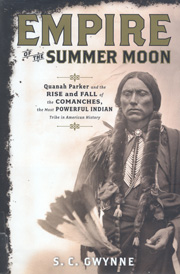 Horses, women and children – those were the stock in trade of Comanche Indians on the Southern Plains and especially in Texas from the mid-1700s to 1875.
Horses, women and children – those were the stock in trade of Comanche Indians on the Southern Plains and especially in Texas from the mid-1700s to 1875.
Empire of the Summer Moon, by S.C. Gwynne (Scribner 2010), tells the story of the rise and fall of the Comanches, the most powerful tribe in American history and, not coincidentally, the most skillful horsemen of the Plains.
“On their feet they are one of the most unattractive and slovenly looking races of Indians I have ever seen, but the moment they mount their horses, they seem at once metamorphosed.” Gwynne quotes from artist and author George Catlin’s writings.
“I am ready, without hesitation, to pronounce the Comanches the most extraordinary horsemen I have seen yet in all my travels.”
Texans won their independence from Mexico in 1836, but found the Comanches in full control as settlers pushed West into the rich Cross Timbers and river valleys. It was during the 1836 massacre at Parker’s Fort that nine-year-old Cynthia Ann Parker was kidnapped by Comanches. Her son, Quanah Parker, fathered by Chief Peta Nocona, would collect his share of scalps before surrendering at Fort Sill, OK, in 1875, as the last chief of the Comanches.
Gwynne’s engrossing book covers the whole saga, from an obscure band of Indians, transformed by horsemanship to become the most feared tribe in North America, to the “civilizing” of Quanah Parker, who participated as an honored guest in Theodore Roosevelt’s 1905 inaugural parade.
It’s a page-turner even if you are acquainted with the history of the era, and especially if you are interested in horses.
